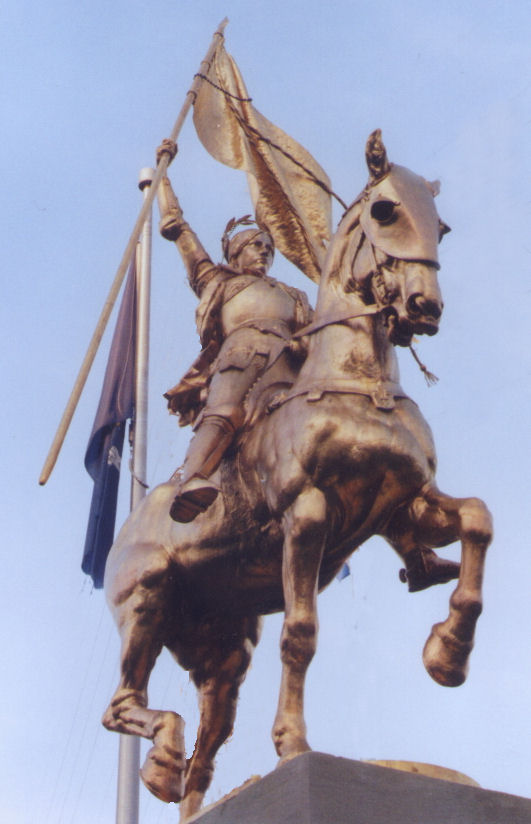
Statue of St. Joan of Arc in New Orleans, Louisiana
In French
Jeanne d’Arc; by her contemporaries commonly known as
la Pucelle (the Maid).
Born at Domremy in Champagne, probably on 6 January, 1412; died at
Rouen, 30 May, 1431. The village of Domremy lay upon the confines of
territory which recognized the suzerainty of the Duke of Burgundy, but
in the protracted conflict between the Armagnacs (the party of Charles
VII, King of France), on the one hand, and the Burgundians in alliance
with the English, on the other, Domremy had always remained loyal to
Charles.
Jacques d’Arc, Joan’s father, was a small peasant farmer, poor but
not needy. Joan seems to have been the youngest of a family of five. She
never learned to read or write but was skilled in sewing and spinning,
and the popular idea that she spent the days of her childhood in the
pastures, alone with the sheep and cattle, is quite unfounded. All the
witnesses in the process of rehabilitation spoke of her as a singularly
pious child, grave beyond her years, who often knelt in the church
absorbed in prayer, and loved the poor tenderly.
Great attempts were
made at Joan’s trial to connect her with some superstitious practices
supposed to have been performed round a certain tree, popularly known as
the “Fairy Tree” (
l’Arbre des Dames), but the sincerity of her
answers baffled her judges. She had sung and danced there with the
other children, and had woven wreaths for Our Lady’s statue, but since
she was twelve years old she had held aloof from such diversions.

Apparition of St. Michael Archangel and St. Catherine to St. Joan of Arc. Painting by Hermann Anton Stilke
It was at the age of thirteen and a half, in the summer of 1425, that
Joan first became conscious of that manifestation, whose supernatural
character it would now be rash to question, which she afterwards came to
call her “voices” or her “counsel.” It was at first simply a voice, as
if someone had spoken quite close to her, but it seems also clear that a
blaze of light accompanied it, and that later on she clearly discerned
in some way the appearance of those who spoke to her, recognizing them
individually as St. Michael (who was accompanied by other angels), St.
Margaret, St. Catherine, and others. Joan was always reluctant to speak
of her voices. She said nothing about them to her confessor, and
constantly refused, at her trial, to be inveigled into descriptions of
the appearance of the saints and to explain how she recognized them.
None the less, she told her judges: “I saw them with these very eyes, as
well as I see you.”
Great efforts have been made by rationalistic historians, such as M.
Anatole France, to explain these voices as the result of a condition of
religious and hysterical exaltation which had been fostered in Joan by
priestly influence, combined with certain prophecies current in the
countryside of a maiden from the
bois chesnu (oak wood), near
which the Fairy Tree was situated, who was to save France by a miracle.
But the baselessness of this analysis of the phenomena has been fully
exposed by many non-Catholic writers. There is not a shadow of evidence
to support this theory of priestly advisers coaching Joan in a part, but
much which contradicts it. Moreover, unless we accuse the Maid of
deliberate falsehood, which no one is prepared to do, it was the voices
which created the state of patriotic exaltation, and not the exaltation
which preceded the voices. Her evidence on these points is clear.
Although Joan never made any statement as to the date at which the
voices revealed her mission, it seems certain that the call of God was
only made known to her gradually. But by May, 1428, she no longer
doubted that she was bidden to go to the help of the king, and the
voices became insistent, urging her to present herself to Robert
Baudricourt, who commanded for Charles VII in the neighbouring town of
Vaucouleurs. This journey she eventually accomplished a month later, but
Baudricourt, a rude and dissolute soldier, treated her and her mission
with scant respect, saying to the cousin who accompanied her: “Take her
home to her father and give her a good whipping.”
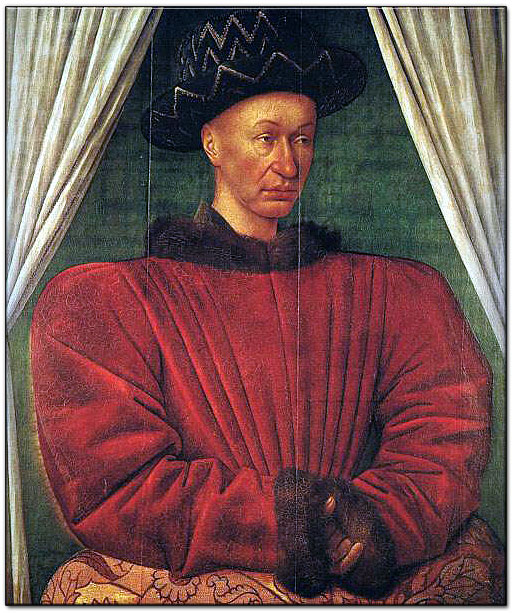
Charles VII, King of France
Meanwhile the military situation of King Charles and his supporters
was growing more desperate. Orléans was invested (12 October, 1428), and
by the close of the year complete defeat seemed imminent. Joan’s voices
became urgent, and even threatening. It was in vain that she resisted,
saying to them: “I am a poor girl; I do not know how to ride or fight.”
The voices only reiterated: “It is God who commands it.” Yielding at
last, she left Domremy in January, 1429, and again visited Vaucouleurs.
Baudricourt was still skeptical, but, as she stayed on in the town,
her persistence gradually made an impression on him. On 17 February she
announced a great defeat which had befallen the French arms outside
Orléans (the Battle of the Herrings). As this statement was officially
confirmed a few days later, her cause gained ground. Finally she was
suffered to seek the king at Chinon, and she made her way there with a
slender escort of three men-at-arms, she being attired, at her own
request, in male costume — undoubtedly as a protection to her modesty in
the rough life of the camp. She always slept fully dressed, and all
those who were intimate with her declared that there was something about
her which repressed every unseemly thought in her regard.
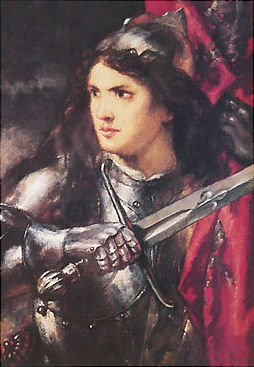
Painting by Sir John Gilbert
She reached Chinon on 6 March, and two days later was admitted into
the presence of Charles VII. To test her, the king had disguised
himself, but she at once saluted him without hesitation amidst a group
of attendants. From the beginning a strong party at the court — La
Trémoille, the royal favorite, foremost among them — opposed her as a
crazy visionary, but a secret sign, communicated to her by her voices,
which she made known to Charles, led the king, somewhat half-heartedly,
to believe in her mission. What this sign was, Joan never revealed, but
it is now most commonly believed that this “secret of the king” was a
doubt Charles had conceived of the legitimacy of his birth, and which
Joan had been supernaturally authorized to set at rest.
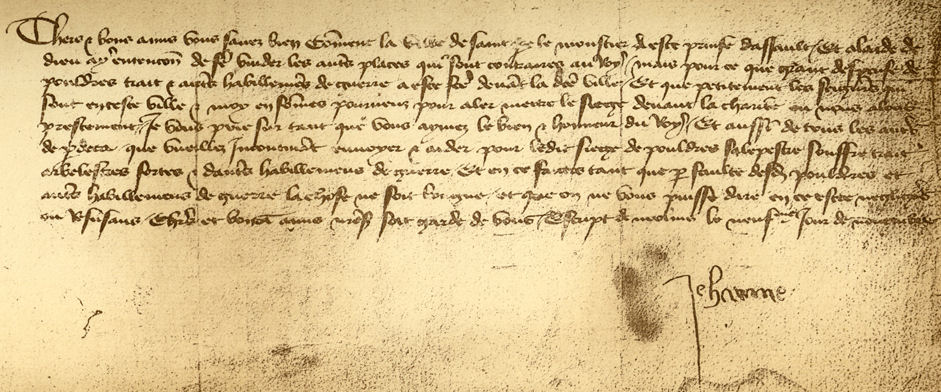
Letter written by St. Joan of Arc to the people of Riom, November 9, 1429.
Still, before Joan could be employed in military operations she was
sent to Poitiers to be examined by a numerous committee of learned
bishops and doctors. The examination was of the most searching and
formal character. It is regrettable in the extreme that the minutes of
the proceedings, to which Joan frequently appealed later on at her
trial, have altogether perished. All that we know is that her ardent
faith, simplicity, and honesty made a favorable impression. The
theologians found nothing heretical in her claims to supernatural
guidance, and, without pronouncing upon the reality of her mission, they
thought that she might be safely employed and further tested.
Returning to Chinon, Joan made her preparations for the campaign.
Instead of the sword the king offered her, she begged that search might
be made for an ancient sword buried, as she averred, behind the altar in
the chapel of Ste-Catherine-de-Fierbois. It was found in the very spot
her voices indicated. There was made for her at the same time a standard
bearing the words
Jesus, Maria, with a picture of God the Father, and kneeling angels presenting a fleur-de-lis.

Statue of St. Joan of Arc with her banner in the Notre-Dame Reims Cathedral, France
But perhaps the most interesting fact connected with this early stage
of her mission is a letter of one Sire de Rotslaer written from Lyons
on 22 April, 1429, which was delivered at Brussels and duly registered,
as the manuscript to this day attests, before any of the events referred
to received their fulfillment. The Maid, he reports, said “that she
would save Orléans and would compel the English to raise the siege, that
she herself in a battle before Orléans would be wounded by a shaft but
would not die of it, and that the King, in the course of the coming
summer, would be crowned at Reims, together with other things which the
King keeps secret.”
Before entering upon her campaign, Joan summoned the King of England
to withdraw his troops from French soil. The English commanders were
furious at the audacity of the demand, but Joan by a rapid movement
entered Orléans on 30 April. Her presence there at once worked wonders.
By 8 May the English forts which encircled the city had all been
captured, and the siege raised, though on the 7th Joan was wounded in
the breast by an arrow.
So far as the Maid went she wished to follow up
these successes with all speed, partly from a sound warlike instinct,
partly because her voices had already told her that she had only a year
to last. But the king and his advisers, especially La Trémoille and the
Archbishop of Reims, were slow to move. However, at Joan’s earnest
entreaty a short campaign was begun upon the Loire, which, after a
series of successes, ended on 18 June with a great victory at Patay,
where the English reinforcements sent from Paris under Sir John Fastolf
were completely routed. The way to Reims was now practically open, but
the Maid had the greatest difficulty in persuading the commanders not to
retire before Troyes, which was at first closed against them. They
captured the town and then, still reluctantly, followed her to Reims,
where, on Sunday, 17 July, 1429, Charles VII was solemnly crowned, the
Maid standing by with her standard, for — as she explained — “as it had
shared in the toil, it was just that it should share in the victory.”

Coronation of Charles VII with St. Joan of Arc by his side. Painting by E. Lenepveu.
The principal aim of Joan’s mission was thus attained, and some
authorities assert that it was now her wish to return home, but that she
was detained with the army against her will. The evidence is to some
extent conflicting, and it is probable that Joan herself did not always
speak in the same tone. Probably she saw clearly how much might have
been done to bring about the speedy expulsion of the English from French
soil, but on the other hand she was constantly oppressed by the apathy
of the king and his advisers, and by the suicidal policy which snatched
at every diplomatic bait thrown out by the Duke of Burgundy.
An abortive attempt on Paris was made at the end of August. Though St-Denis was
occupied
without opposition, the assault which was made on the city on 8
September was not seriously supported, and Joan, while heroically
cheering on her men to fill the moat, was shot through the thigh with a
bolt from a crossbow.
The Duc d’Alençon removed her almost by force, and
the assault was abandoned. The reverse unquestionably impaired Joan’s
prestige, and shortly afterwards, when, through Charles’ political
counselors, a truce was signed with the Duke of Burgundy, she sadly laid
down her arms upon the altar of St-Denis.
The inactivity of the following winter, mostly spent amid the
worldliness and the jealousy of the Court, must have been a miserable
experience for Joan. It may have been with the idea of consoling her
that Charles, on 29 December, 1429, ennobled the Maid and all her
family, who henceforward, from the lilies on their coat of arms, were
known by the name of Du Lis. It was April before Joan was able to take
the field again at the conclusion of the truce, and at Melun her voices
made known to her that she would be taken prisoner before Midsummer Day.
Neither was the fulfillment of this prediction long delayed. It seems
that she had thrown herself into Compiègne on 24 May at sunrise to
defend the town against Burgundian attack. In the evening she resolved
to attempt a sortie, but her little troop of some five hundred
encountered a much superior force.
Her followers were driven back and
retired desperately fighting. By some mistake or panic of Guillaume de
Flavy, who commanded in Compiègne, the drawbridge was raised while still
many of those who had made the sortie remained outside, Joan amongst
the number. She was pulled down from her horse and became the prisoner
of a follower of John of Luxemburg. Guillaume de Flavy has been accused
of deliberate treachery, but there seems no adequate reason to suppose
this. He continued to hold Compiègne resolutely for his king, while
Joan’s constant thought during the early months of her captivity was to
escape and come to assist him in this task of defending the town.

On December 29, 1429, in praise of her great
deeds, King Charles VII officially ennobled the d'Arc lineage in
perpetuity by granting them the surname "du Lys". At the request of St.
Joan of Arc, King Charles also remitted the taxes on the people of
Domrémy, which was upheld until the French Revolution.
No words can adequately describe the disgraceful ingratitude and
apathy of Charles and his advisers in leaving the Maid to her fate. If
military force had not availed, they had prisoners like the Earl of
Suffolk in their hands, for whom she could have been exchanged. Joan was
sold by John of Luxembourg to the English for a sum which would amount
to several hundred thousand dollars in modern money. There can be no
doubt that the English, partly because they feared their prisoner with a
superstitious terror, partly because they were ashamed of the dread
which she inspired, were determined at all costs to take her life. They
could not put her to death for having beaten them, but they could get
her sentenced as a witch and a heretic.
Moreover, they had a tool ready to their hand in Pierre Cauchon, the
Bishop of Beauvais, an unscrupulous and ambitious man who was the
creature of the Burgundian party. A pretext for invoking his authority
was found in the fact that Compiègne, where Joan was captured, lay in
the Diocese of Beauvais. Still, as Beauvais was in the hands of the
French, the trial took place at Rouen — the latter see being at that
time vacant. This raised many points of technical legality which were
summarily settled by the parties interested.
The Vicar of the Inquisition at first, upon some scruple of
jurisdiction, refused to attend, but this difficulty was overcome before
the trial ended. Throughout the trial Cauchon’s assessors consisted
almost entirely of Frenchmen, for the most part theologians and doctors
of the University of Paris. Preliminary meetings of the court took place
in January, but it was only on 21 February, 1431, that Joan appeared
for the first time before her judges. She was not allowed an advocate,
and, though accused in an ecclesiastical court, she was throughout
illegally confined in the Castle of Rouen, a secular prison, where she
was guarded by dissolute English soldiers.
Joan bitterly complained of
this. She asked to be in the church prison, where she would have had
female attendants. It was undoubtedly for the better protection of her
modesty under such conditions that she persisted in retaining her male
attire. Before she had been handed over to the English, she had
attempted to escape by desperately throwing herself from the window of
the tower of Beaurevoir, an act of seeming presumption for which she was
much browbeaten by her judges. This also served as a pretext for the
harshness shown regarding her confinement at Rouen, where she was at
first kept in an iron cage, chained by the neck, hands, and feet. On the
other hand she was allowed no spiritual privileges — e.g. attendance at
Mass — on account of the charge of heresy and the monstrous dress (
difformitate habitus) she was wearing.

The Trial of Joan of Arc, Painting by Louis Boutet de Monvel
As regards the official record of the trial, which, so far as the
Latin version goes, seems to be preserved entire, we may probably trust
its accuracy in all that relates to the questions asked and the answers
returned by the prisoner. These answers are in every way favourable to
Joan. Her simplicity, piety, and good sense appear at every turn,
despite the attempts of the judges to confuse her. They pressed her
regarding her visions, but upon many points she refused to answer. Her
attitude was always fearless, and, upon 1 March, Joan boldly announced
that “within seven years’ space the English would have to forfeit a
bigger prize than Orléans.” In point of fact Paris was lost to Henry VI
on 12 November, 1437 — six years and eight months afterwards.
It was
probably because the Maid’s answers perceptibly won sympathizers for her
in a large assembly that Cauchon decided to conduct the rest of the
inquiry before a small committee of judges in the prison itself. We may
remark that the only matter in which any charge of prevarication can be
reasonably urged against Joan’s replies occurs especially in this stage
of the inquiry. Joan, pressed about the secret sign given to the king,
declared that an angel brought him a golden crown, but on further
questioning she seems to have grown confused and to have contradicted
herself. Most authorities (like, e.g., M. Petit de Julleville and Mr.
Andrew Lang) are agreed that she was trying to guard the king’s secret
behind an allegory, she herself being the angel; but others — for
instance P. Ayroles and Canon Dunand — insinuate that the accuracy of
the
procès-verbal cannot be trusted. On another point she was
prejudiced by her lack of education.
The judges asked her to submit
herself to “the Church Militant.” Joan clearly did not understand the
phrase and, though willing and anxious to appeal to the pope, grew
puzzled and confused. It was asserted later that Joan’s reluctance to
pledge herself to a simple acceptance of the Church’s decisions was due
to some insidious advice treacherously imparted to her to work her ruin.
But the accounts of this alleged perfidy are contradictory and
improbable.

St. Joan of Arc being led to her execution in Rouen. Painting by Isidore Patrois
The examinations terminated on 17 March. Seventy propositions were
then drawn up, forming a very disorderly and unfair presentment of
Joan’s “crimes,” but, after she had been permitted to hear and reply to
these, another set of twelve were drafted, better arranged and less
extravagantly worded. With this summary of her misdeeds before them, a
large majority of the twenty-two judges who took part in the
deliberations declared Joan’s visions and voices to be “false and
diabolical,” and they decided that if she refused to retract she was to
be handed over to the secular arm — which was the same as saying that
she was to be burned.
Certain formal admonitions, at first private, and
then public, were administered to the poor victim (18 April and 2 May),
but she refused to make any submission which the judges could have
considered satisfactory. On 9 May she was threatened with torture, but
she still held firm. Meanwhile, the twelve propositions were submitted
to the University of Paris, which, being extravagantly English in
sympathy, denounced the Maid in violent terms. Strong in this approval,
the judges, forty-seven in number, held a final deliberation, and
forty-two reaffirmed that Joan ought to be declared heretical and handed
over to the civil power, if she still refused to retract. Another
admonition followed in the prison on 22 May, but Joan remained unshaken.
The next day a stake was erected in the cemetery of St-Ouen, and in the
presence of a great crowd she was solemnly admonished for the last
time.
After a courageous protest against the preacher’s insulting
reflections on her king, Charles VII, the accessories of the scene seem
at last to have worked upon mind and body worn out by so many struggles.
Her courage for once failed her. She consented to sign some sort of
retraction, but what the precise terms of that retraction were will
never be known. In the official record of the process a form of
retraction is in inserted which is most humiliating in every particular.
It is a long document which would have taken half an hour to read. What
was read aloud to Joan and was signed by her must have been something
quite different, for five witnesses at the rehabilitation trial,
including Jean Massieu, the official who had himself read it aloud,
declared that it was only a matter of a few lines. Even so, the poor
victim did not sign unconditionally, but plainly declared that she only
retracted in so far as it was God’s will. However, in virtue of this
concession, Joan was not then burned, but conducted back to prison.
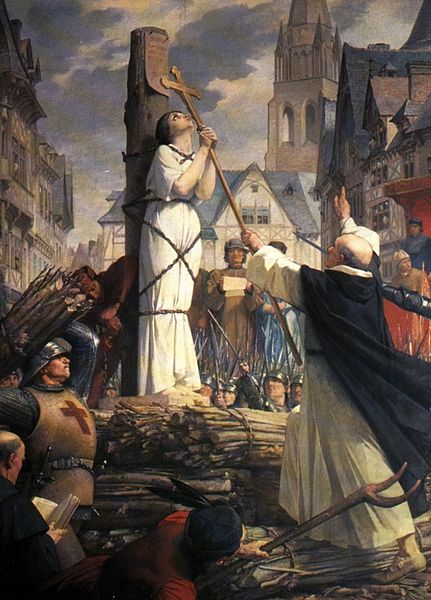
Enveloped in flames, Joan cried out the name of Jesus six times before dying.
The English and Burgundians were furious, but Cauchon, it seems,
placated them by saying, “We shall have her yet.” Undoubtedly her
position would now, in case of a relapse, be worse than before, for no
second retraction could save her from the flames. Moreover, as one of
the points upon which she had been condemned was the wearing of male
apparel, a resumption of that attire would alone constitute a relapse
into heresy, and this within a few days happened, owing, it was
afterwards alleged, to a trap deliberately laid by her jailers with the
connivance of Cauchon. Joan, either to defend her modesty from outrage,
or because her women’s garments were taken from her, or, perhaps, simply
because she was weary of the struggle and was convinced that her
enemies were determined to have her blood upon some pretext, once more
put on the man’s dress which had been purposely left in her way.
The end
now came soon. On 29 May a court of thirty-seven judges decided
unanimously that the Maid must be treated as a relapsed heretic, and
this sentence was actually carried out the next day (30 May, 1431) amid
circumstances of intense pathos. She is said, when the judges visited
her early in the morning, first to have charged Cauchon with the
responsibility of her death, solemnly appealing from him to God, and
afterwards to have declared that “her voices had deceived her.”
About
this last speech a doubt must always be felt. We cannot be sure whether
such words were ever used, and, even if they were, the meaning is not
plain. She was, however, allowed to make her confession and to receive
Communion. Her demeanor at the stake was such as to move even her bitter
enemies to tears. She asked for a cross, which, after she had embraced
it, was held up before her while she called continuously upon the name
of Jesus. “Until the last,” said Manchon, the recorder at the trial,
“she declared that her voices came from God and had not deceived her.”
After death her ashes were thrown into the Seine.

The beatification of St. Joan of Arc
Twenty-four years later a revision of her trial, the
procès de réhabilitation,
was opened at Paris with the consent of the Holy See. The popular
feeling was then very different, and, with but the rarest exceptions,
all the witnesses were eager to render their tribute to the virtues and
supernatural gifts of the Maid. The first trial had been conducted
without reference to the pope, indeed it was carried out in defiance of
St. Joan’s appeal to the head of the Church. Now an appellate court
constituted by the pope, after long inquiry and examination of
witnesses, reversed and annulled the sentence pronounced by a local
tribunal under Cauchon’s presidency.
The illegality of the former
proceedings was made clear, and it speaks well for the sincerity of this
new inquiry that it could not be made without inflicting some degree of
reproach upon both the King of France and the Church at large, seeing
that so great an injustice had been done and had so long been suffered
to continue unredressed. Even before the rehabilitation trial, keen
observers, like Eneas Sylvius Piccolomini (afterwards Pope Pius II),
though still in doubt as to her mission, had discerned something of the
heavenly character of the Maid. In Shakespeare’s day she was still
regarded in England as a witch in league with the fiends of hell, but a
juster estimate had begun to prevail even in the pages of Speed’s
“History of Great Britaine” (1611).
By the beginning of the nineteenth
century the sympathy for her even in England was general. Such writers
as Southey, Hallam, Sharon Turner, Carlyle, Landor, and, above all, De
Quincey greeted the Maid with a tribute of respect which was not
surpassed even in her own native land. Among her Catholic
fellow-countrymen she had been regarded, even in her lifetime, as
Divinely inspired.
At last the cause of her beatification was introduced upon occasion
of an appeal addressed to the Holy See, in 1869, by Mgr Dupanloup,
Bishop of Orléans, and, after passing through all its stages and being
duly confirmed by the necessary miracles, the process ended in the
decree being published by Pius X on 11 April, 1909. A Mass and Office of
St. Joan, taken from the “Commune Virginum,” with “proper” prayers,
have been approved by the Holy See for use in the Diocese of Orléans.
HERBERT THURSTON (Catholic Encyclopedia)

- Photo of the Canonization of St. Joan of Arc on May 16, 1920.














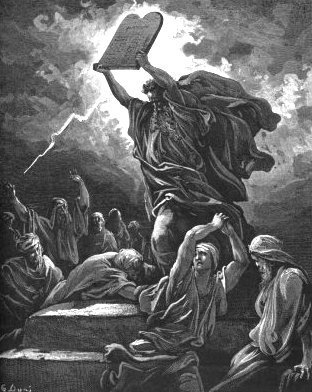
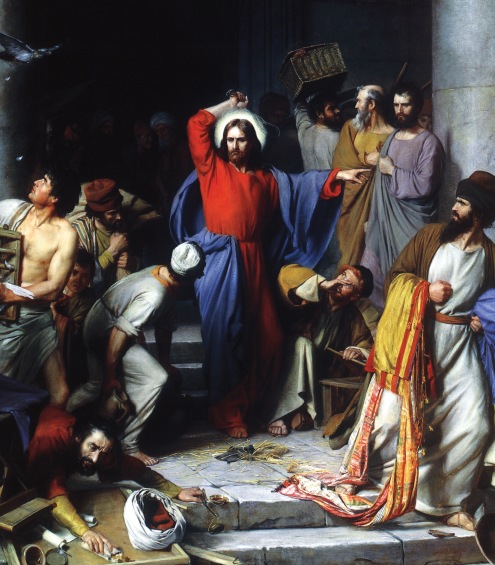
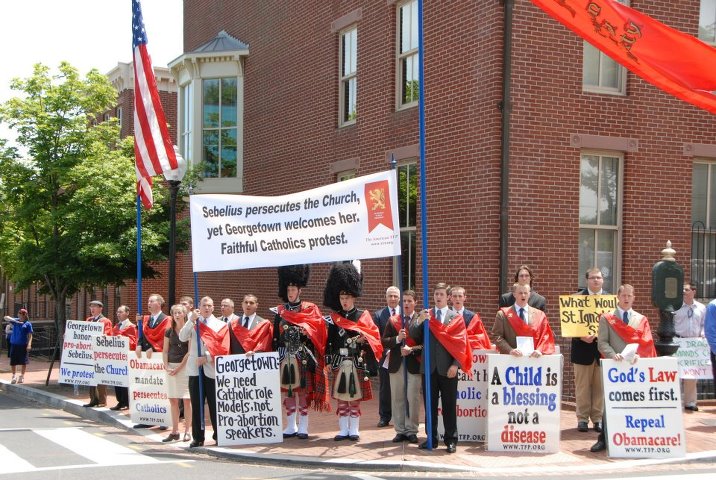

 Such
invocation took a new turn in the Catholic world due to the action of
one of the greatest saints of modern times: Saint John Bosco, founder
of the Society of Saint Francis of Sales (Salesians) and of the
Institute of the Daughters of Mary Help of Christians.
Such
invocation took a new turn in the Catholic world due to the action of
one of the greatest saints of modern times: Saint John Bosco, founder
of the Society of Saint Francis of Sales (Salesians) and of the
Institute of the Daughters of Mary Help of Christians.







 Not only has the evolutionary theory remained frozen, but their anti-creation rhetoric also seems to be stuck in time.
Not only has the evolutionary theory remained frozen, but their anti-creation rhetoric also seems to be stuck in time.

